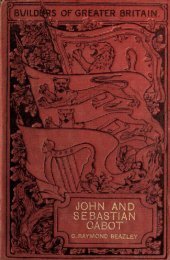st. john of damascus (676-749 - Cristo Raul
st. john of damascus (676-749 - Cristo Raul
st. john of damascus (676-749 - Cristo Raul
Create successful ePaper yourself
Turn your PDF publications into a flip-book with our unique Google optimized e-Paper software.
"<br />
"<br />
"<br />
ON NATURAL SCIENCE.<br />
would be blasphemously to assign to them the same<br />
power as to Chri<strong>st</strong>.<br />
The reader may be disposed to think that in thus<br />
arguing, with reasons <strong>of</strong> whatever soundness, again<strong>st</strong><br />
the popular super<strong>st</strong>itions <strong>of</strong> his country, John <strong>of</strong><br />
Damascus appears in a character somewhat at variance<br />
with that under which we have viewed him elsewhere,<br />
as the defender <strong>of</strong> image-worship. But, as Neander<br />
points out, there is no real inconsi<strong>st</strong>ency. We see<br />
no good reason/ he says, why a defender <strong>of</strong> imageworship<br />
might not at the same time set himself to<br />
oppose that species <strong>of</strong> super<strong>st</strong>ition. His conduct, in<br />
both cases alike, proceeded from religious motives.<br />
Image-worship . . . appears to him a practice alto<br />
gether correspondent with the spirit <strong>of</strong> Chri<strong>st</strong>ianity,<br />
and conformable to reason; but these <strong>st</strong>ories he<br />
regarded as alike repugnant<br />
to Chri<strong>st</strong>ian truth and<br />
reason. He ascribes the spread <strong>of</strong> the latter super<br />
<strong>st</strong>ition<br />
among the people to the fact that they were<br />
kept in such total ignorance <strong>of</strong> the Scriptures. He<br />
insi<strong>st</strong>s that laymen <strong>of</strong> all classes, even soldiers and<br />
peasants, ought<br />
biblical tendency," he adds,<br />
to read the sacred word." "This<br />
might seem to collide<br />
with the traditional one <strong>of</strong> a zealous image-worshipper;<br />
but neither are these contrarieties <strong>of</strong> such a nature<br />
that they might not exi<strong>st</strong><br />
together in the same indi<br />
vidual."<br />
One other fragment may be noticed. 1<br />
It appears<br />
to have formed part <strong>of</strong> a letter, and in its present<br />
form is headed Quid e<strong>st</strong> homo ? What is man ? It<br />
occupies but a single column, and breaks <strong>of</strong>f in the<br />
1<br />
Migne s ed., vol. ii., p. 243.
















